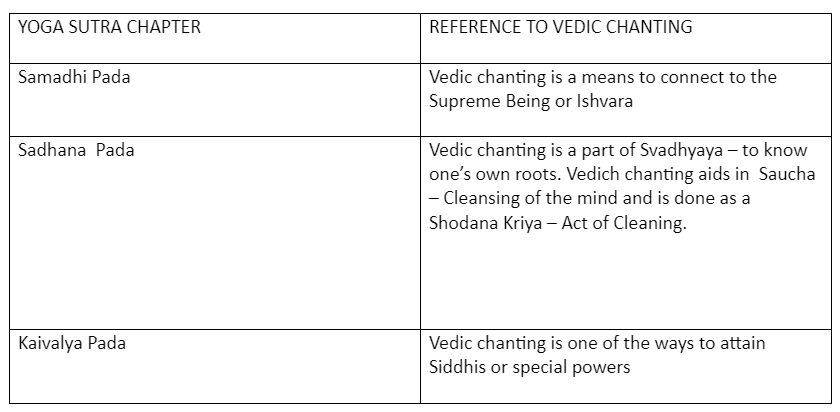A much awaited session it was for me. The session that was — Invoking Sacred chants.
Vedic Chanting is practice that is prevalent in India, even today. Can you believe that a practice which had its origin many thousands of years back is surviving today? In a language which is no more used in common parlance, chants have always made me wonder why or what exactly they are. This session is a step closer to the exploration and understanding of this age-old practice.
AYS featured on 21st June, a live session with Mrs. Sujaya Isaac, a student of Shri T.K.V Desikachar , teacher of Yoga philosophy, practice, therapy and chanting for more than 35 years. The following article is about what I learnt from the session.
A PRAYER INVOKING HEALTH
Sujaya ji started the session with a definition of Vedic chanting referred to as Veda adhyayanam in Sanskrit. Veda adhyananam means to repeat what is said by the Guru as it is said. So vedic chanting lies on the ability to listen and repeat what is said by the Guru .
Any chanting session always begins with a prayer to the almighty and so did this session. All I had to do was to close my eyes and listen to what is being said.
Sujaya ji then chanted the Ayur Mantra — A chanting invoking the gods to provide us with Good health. A progressive chant in which we seek good health in all aspects from the physical , to the mental and to the spiritual.
It reckoned on me that such a seeking is what we are all after or rather in fact should be every day.
MANTRA
What exactly is a mantra? This too was answered in the session. A mantra is a syllable, or word, or phrase or paragraph which has a divine connect.
The mantra then defines that which is the highest. The mantras are meant to protect the mind, to give clarity and to bring harmony and joy. The mantras also bring freedom from fear, freedom from guilt.
The Vedic chants are basically revelations that appeared to the ancient seers or rishis who then delivered them for the good of mankind.
Isn’t this what scientists are meant to do today? Just a question to think about
RECITATION
Almost all of us are familiar with the Gayathri mantra today. This is said by some as the most powerful mantra. How familiar are you with it? Let me guess, most today would have heard the version that was made famous by the Audio series cassette that were released. Am I correct?
Suajaya ji explained that this is not the right way to do the chant. A chant is repeated as listened from a Guru. We should stick to the rules. The session explained the difference between a Vedic chant and a non Vedic chant

The session had Sujaya ji explaining the chanting with examples. It is a must watch. So in case you missed the session do check the IGTV available at AYS page in Instagram.
Learning Vedic chanting is a process that is done with the Guru in person. It is like an art where the teacher transfers the method, the intonations, the breath regulation that follows a mantra pattern to the disciple.
The vedas are recited in the Sanskrit language. Known as the language of the gods, Sanskrit has no silent letters and every letter in the chant has to be heard.
“If it is not heard then it is not said “, Sujaya ji explained in her session.
The mantras have meaning and hence what is said is very important. A little mispronunciation here you will be asking God what you did not intend. That would be like Kumbhakarna (Ravana’s Brother the rakhasa) who by this mis pronunciation got the boon of an undisturbed sleep for 6 months every year.
YOGA AND VEDIC CHANTING
The Yoga and Vedas have a close relationship . Yoga is one of the 6 Dharshanas ( School of thoughts) in which man approached fundamental questions about life and Vedas form a major part of Mimansa and Vedanta which are 2 other Dharashanas.
Sujaya ji explained that the Yoga Sutras by Patanjali refers in Chapters 1, 2 and 4 to Vedic Chanting and the benefits they yield .

There are other texts such as the Yoga Ragasya composed by Natha Muni which says that the best Pranayama is the one which is done with a Mantra
WOMEN AND CHANTING
It is a very common notion that Vedic chanting should not be done by Women. Sujaya ji explained that this is a very common misapprehension that is prevalent for a long time. Shri Krishnamacarya emphasised on women learning vedic chanting and use for adhyayanam .He was far sighted to sense that without women such a tool would be lost to the future human generations.
Also, there happens to be no reference in the Vedas that it should not be chanted by Women. A thought-provoking statement in the session was when Sujaya ji told that there is no gender in Self Realisation.
EXPLORE THIS DIMENSION OF YOGA
What lies hidden in Yoga is immense and infinite is what I understand. It is upto us to explore it to whatever extent we want. Nevertheless, the goal is to delve deeper. We should explore this dimension of Yoga and experience what it offers. Thanks to the Great Gurus who have ensured that we have a right authority to learn it from.
Do Watch the IGTV Session and listen to some beautiful chanting done by Suajaya ji.
IGTV recording: https://www.instagram.com/tv/CBr1x7UjyrF/?utm_source=ig_web_copy_link
PS : All vedic chanting sessions in the Krishnamacarya traditions come to an end with an end prayer called the Shama sloka seeking forgiveness for the various mistakes we made in uttering the words listened to and also with a prayer where we offer all things said and done to the Supreme being.

